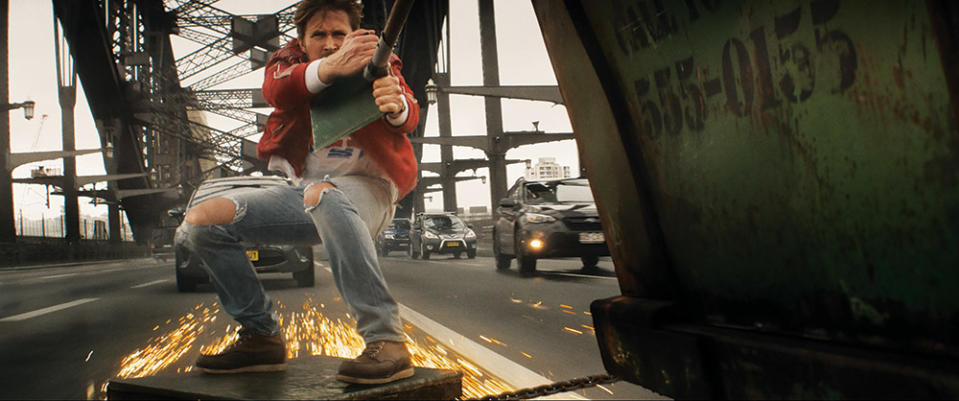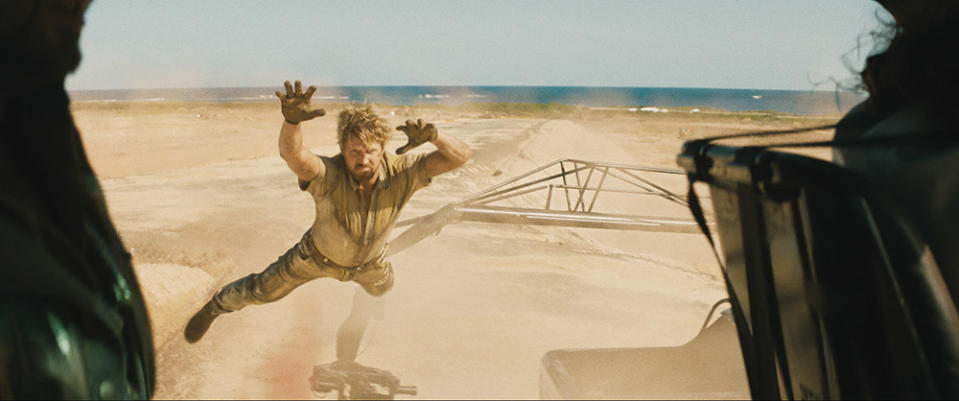They Get Hit by Cars for Your Amusement. Will ‘The Fall Guy’ Get Them a Little Love?
- Oops!Something went wrong.Please try again later.
- Oops!Something went wrong.Please try again later.
- Oops!Something went wrong.Please try again later.

In a scene early in The Fall Guy, a nameless crewmember buckles Ryan Gosling’s seat belt as his character is about to attempt a cannon roll, a classic car stunt, on the set of a fictional science fiction movie called Metal Storm. Gosling plays Hollywood stuntman Colt Seavers, who is reluctantly returning to the film business after an injury, but in many ways the real star of the scene is the background actor buckling him in, Logan Holladay. Though his screen time lasts only a few moments, Holladay was the real-life stunt driver for Gosling — the one who actually steered a Jeep Grand Cherokee down a Sydney beach and rolled it eight and a half times on the sand, breaking the Guinness world record of seven rolls set by Adam Kirley, the driver of James Bond’s Aston Martin in 2006’s Casino Royale.
“I’m like, ‘Whoa, man, am I upside down?’ ” Holladay says, explaining the sensation of performing the record stunt, in which, according to a G-force meter that was placed under his butt, he felt up to 16 Gs of force on his body. (For comparison, elite jet fighter pilots manage 9 Gs for a second or two.) “If I relax, my arms fly up. So, I know, OK, yeah, I am upside down.” Holladay, like many stunt performers, is much better at making movie magic than at talking about his role in it. Stoicism and avoiding attention are part of the traditional stunt performers’ code. But for this interview, he’s being thrust into the spotlight by his Fall Guy director, David Leitch, a former stuntman who is part of an industry effort to get stunt performers more recognition for their work, and perhaps one day even an Oscar.
More from The Hollywood Reporter
Ryan Gosling Says 'The Nice Guys' Didn't Get a Sequel Because 'Angry Birds' "Destroyed Us"
Ryan Gosling Says Eva Mendes and Their Family Are His North Star
“Anonymity has always been the contract that we’ve agreed to, and it’s partly for the audience’s benefit,” says Leitch, who was Brad Pitt’s stunt double for a decade starting with Fight Club, and went on to direct action-driven films like John Wick (with Chad Stahelski), Bullet Train, Deadpool 2 and Fast & Furious Presents: Hobbs & Shaw. “We’re trying to keep the illusion alive.” But what Leitch and his peers want people to know more about is the art behind that illusion. “It’s not just that we risk things,” Leitch says. “We design these sequences. The amount of technical knowledge, skill, experience, ingenuity and creativity that went into pulling off that stunt — it is just time to have the conversation that stuntpeople are integral to cinema.”
In order for stunt performers to earn a competitive Oscar, their community will have to complete a veritable parkour course of Academy bureaucracy. For the first time in decades, that maneuver is starting to seem possible thanks to a new openness at the Academy and a growing awareness that stunts are about more than collecting some impressive scars.

Among the ways that Leitch and Kelly McCormick, his wife and partner at their production company, 87North, are trying to push the conversation forward is their new docuseries Action about the personal lives of stunt performers (including those in The Fall Guy) that will stream on Peacock starting April 26. Leitch and McCormick are also behind the creation of a new film credit, “stunt designer,” which is being awarded for the first time to Chris O’Hara on The Fall Guy, for the job that is traditionally called stunt coordinator. From both a safety and a creative perspective, it is the stunt coordinator who designs, casts and manages the stunt work on a film. “People inside the Academy don’t understand the word ‘coordinator’ to mean artist,” says McCormick, who worked with the Screen Actors and Directors guilds to get the new credit approved. “It helps with that nomenclature. Production designer, hair designer. We’re making clear that there is artistry in this.”
***
The Fall Guy, which Universal will release May 3, is a loose adaptation of the 1980s ABC series that starred Lee Majors as a stuntman who moonlights as a bounty hunter. The film had languished in development for more than a decade at both Warner Bros. and DreamWorks, with Dwayne Johnson and Nicolas Cage each attached at one point. Leitch and McCormick were looking for a project that would showcase Leitch’s talent for conceiving and executing dazzling original set pieces when Management 360 (since rebranded as Entertainment 360) founding partner Guymon Casady, who held the Fall Guy rights, approached them in 2020. The film seemed like a natural fit — the TV show had been inspirational to Leitch’s generation of stunt performers, and with a stuntman protagonist, he would have an excuse to do for stunts what Rocky had done for boxing: Elevate an underdog hero by showcasing the craft. That pitch attracted Gosling, and Leitch enlisted Hobbs & Shaw writer Drew Pearce to work on the script. He would round out the cast with Emily Blunt as an ambitious first-time director who is Colt’s ex-girlfriend, Aaron Taylor-Johnson as the preening action star Colt is doubling for, Winston Duke as the film’s genial stunt coordinator and Hannah Waddingham as its mercenary executive producer.

Before Pearce’s script was done, Leitch had O’Hara prepping stunts he knew he’d want, including a chase scene on Sydney Harbour Bridge, a 225-foot car jump, a boat jump, a 150-foot fall from a helicopter and, of course, the cannon roll. “I knew the logistical nightmare I was handing him,” Leitch says. ” ‘You’d better get on that now.’ ” Every filmmaker’s process is different, but on action movies, the director and stunt coordinator typically work together to dream up inventive sequences. 87North’s films take that a step further, with stunts and set pieces coming before dialogue and a polished screenplay. “To be honest, the script is the least important thing,” Leitch says. “The story and the characters, the theme, the tone, these are all locked. But how we get to that can evolve. When you say that to people, they’re just like, ‘What?’ ” While Leitch and O’Hara were spitballing set pieces, Ben Jenkin — one of Gosling’s four stunt doubles, including Holladay on the vehicle sequences — tossed in a couple of requests. “Before the script was even fleshed out, Ben goes, ‘I want to get hit by a car and I want to be set on fire,’ ” O’Hara says. Jenkin, who had never done a fire stunt, had his wishes fulfilled, and over the course of two days he was set on fire eight times. The feeling, Jenkin says, is “surprisingly quite cold, because you’re covered in fire gel.” More noteworthy is the preparation, which included practicing with small amounts of fire and building up skill and tolerance. “Stunts is a very physical job, but also you have to be mentally strong,” Jenkin says. “You have to manage your thoughts, your fears, keep it all under control, and then the physical aspect kind of happens. People have different ways of handling it beforehand. I just like getting in the zone, pop an AirPod in and listen to some music and visualize what I’m going to do.”
***
Stunt work has been central to film since cinema’s earliest days, from Harold Lloyd dangling off the minute hand of a clock on a downtown L.A. office building in 1923’s Safety Last! to Yakima Canutt being dragged by a team of horses in 1939’s Stagecoach. There is no competitive Oscar for stunts, but in 1967 Canutt was awarded an honorary Oscar for his achievements, including the safety devices he developed, and in 2012 Hal Needham, best known for his stunt work with Burt Reynolds, also received one. In 2007, SAG introduced a best stunt ensemble award, won this year by Mission: Impossible — Dead Reckoning Part One, but in a sign that stunt performers are still the Rodney Dangerfield members of their union, SAG announced that award during its red carpet preshow rather than the main telecast.

For more than 30 years, stunt coordinator Jack Gill, who has worked on more than 185 movies and shows including Fast X and Captain America: Civil War, has been banging on the Academy’s door trying to get a competitive Oscar process going. Recently, there has been a little cause for hope. In March 2023, the Academy created a Production and Technology branch, into which stunt coordinators now fall (they previously fell in the Members at Large branch, a group consisting largely of agents and managers). There are more than 100 stunt professionals in the branch, the largest group among the 400-member body, which also includes crafts such as choreographers and music supervisors. In February of this year, the Academy announced the creation of a new Oscar category for casting directors to begin with 2025 films, marking the first new category the group has introduced since it created the animated feature Oscar in 2001. In order to have their own Oscar category, stunt performers will have to follow the casting directors’ template: They must develop and submit a proposal to the Production and Technology branch’s executive committee, then bring it to the Academy’s Awards Committee and finally present the proposal to the Academy’s Board of Governors for approval. One Academy member’s reaction to the idea of a stunt Oscar suggests what the campaign is up against. “How will this be judged?” the member says. “Who is coming up with criteria? How can a layperson have any idea what goes into this? Is it really the same thing as costume design? It involves skill, but is it artistry?” Academy CEO Bill Kramer, president Janet Yang and chief Oscars officer Teni Melidonian have been providing the stunt community with the blueprint for creating the category, McCormick says. “They’ve been giving us the history,” she says. “They’ve said, ‘This is how casting did it. If you follow those steps, there’s a chance.’ We’ve felt they have embraced us with open arms.”

The Academy, which declined to comment for this story, has a pragmatic reason to offer stunt performers that kind of welcome. As the ratings for awards shows of all types have lagged over the past decade, stunt-heavy popcorn films provide potential tune-in appeal for audiences who avoid the art house movies often nominated in other categories. A sign of the Academy’s embrace came at this year’s Oscars, when Gosling and his Fall Guy co-star Emily Blunt, nominated for their roles in Barbie and Oppenheimer, respectively, introduced a tribute to stunt performers, with Gosling calling them “fearless artisans” and teeing up a video reel featuring action scenes from films like Ben-Hur, Titanic and RRR.
The Oscar tribute was also a pretty savvy publicity stunt for The Fall Guy, which Universal premiered two days later at SXSW, where THR‘s critic called it “the rare big studio film that feels human.” That humanity is due in great part to the film’s analog stunts, with judicious deployment of CGI to make the performers safer. The filmmakers digitally removed a safety line they used, for instance, to drag the real Gosling across a bridge at 30 miles an hour. It wasn’t that long ago that industry observers watching the introduction of digital stunts on films like Titanic predicted that human stunts would disappear entirely. “When I got in the business 30 years ago, people said I had 10 years left,” O’Hara says. “Why even start because you’re going to be replaced in a decade?” Many modern tentpole films devote their third acts to the destruction of computer-generated worlds and characters, but O’Hara thinks he still has a job because audiences can feel when there are real human bodies at stake. “When everything is so visual effects-heavy, I don’t know what’s real and what’s not real [in those films],” he says. Universal is leaning into the appeal of human stunt performers to promote the film in other ways, too, launching a Fall Guy-themed stunt show produced by Leitch’s company at its Hollywood theme park to run through May 19.
Leitch believes audiences are more sophisticated than they used to be about the tools of filmmaking, and one particularly meta set piece in the third act of The Fall Guy takes viewers behind the scenes of the fictional Metal Storm movie. In the scene, which ended up on the poster, Blunt drives a camera car — the vehicle usually used to shoot another vehicle — while Gosling dangles from the camera crane mounted on its roof. “If we would’ve made this 10 years ago, the studio would’ve been like, ‘It’s too inside baseball,’ ” Leitch says. ” ‘Nobody cares about that world. They won’t understand it.’ But audiences are getting savvy. There’s all this behind-the-scenes footage. People really are interested in how movies are made and it becomes pretty clear that there’s a lot of people behind the scenes. It’s like, these people are here, they exist and they are doing amazing things.”

This story first appeared in the April 24 issue of The Hollywood Reporter magazine. Click here to subscribe.
Best of The Hollywood Reporter

